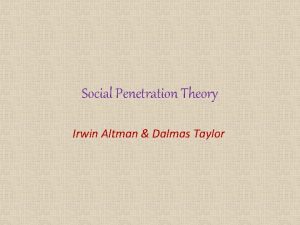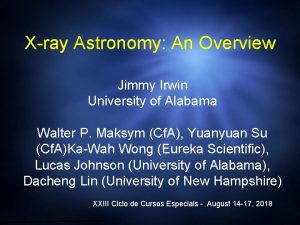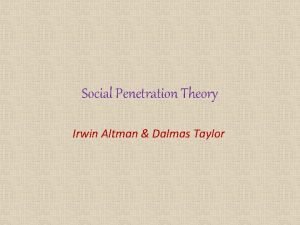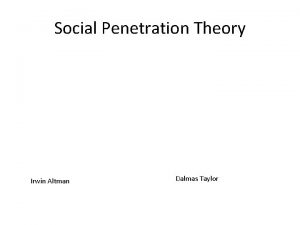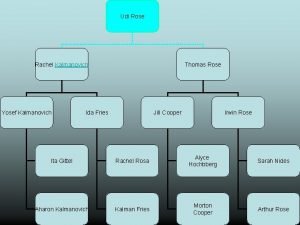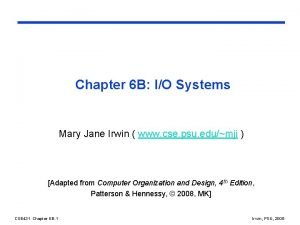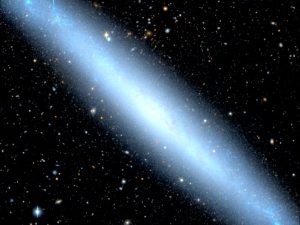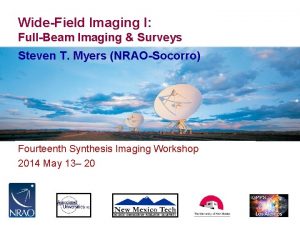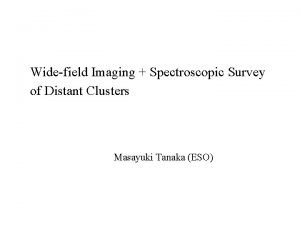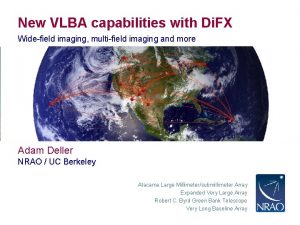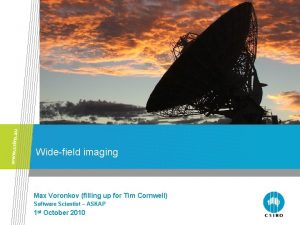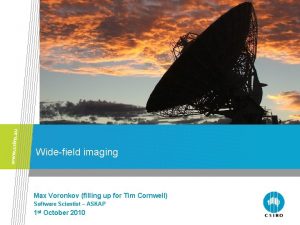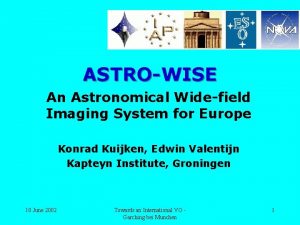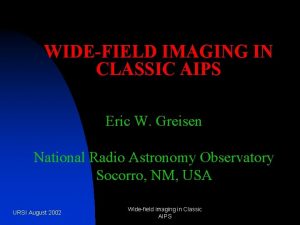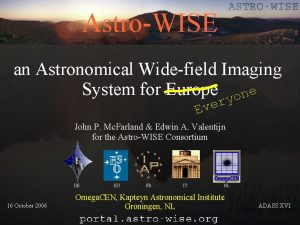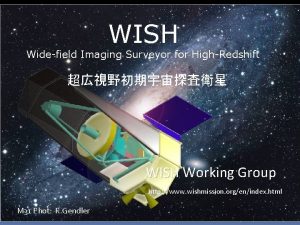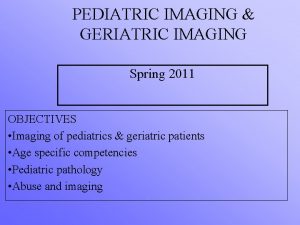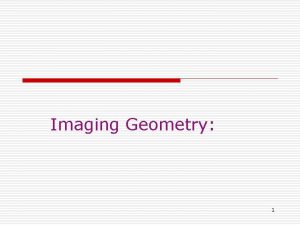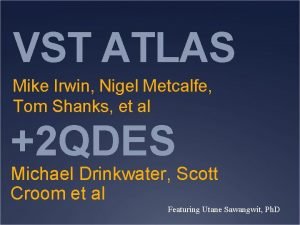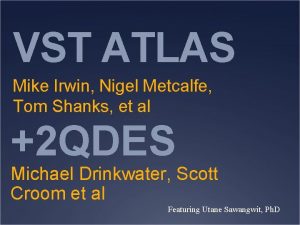Processing WideField Imaging data Mike Irwin N 4244














![Astrometric Calibration 2 MASS [UCAC, SDSS] WCS - ZPN projection Linear solution per detector Astrometric Calibration 2 MASS [UCAC, SDSS] WCS - ZPN projection Linear solution per detector](https://slidetodoc.com/presentation_image_h2/6036624a0b1a8cdff339326dfa145226/image-15.jpg)






- Slides: 21

Processing Wide-Field Imaging data Mike Irwin

N 4244 confidence map stack 20 dithered i-band frames Subaru 8 m CTIO 4 m KPNO 4 m CFH 3. 6 m INT 2. 5 m ESO 2. 2 m DART

WFPC 2 Suprime. Cam

1000 Tb IPHAS 10 Tb 100 Tb

overall data structure all primary I/O multi-extension FITS files (MEFs) telescope info PHU, detector-specific info SHU raw + processed data stored Rice-compressed = lossless + FITS + efficient + 3 -5 less storage LTO tape backups for offline store reliable transfer of data often a bottleneck object catalogues generated as MEF binary tables

overall processing philosophy pipelines driven by FITS keywords + overall observing structure pipeline processing controlled from scripts use individual software modules for specific tasks use CFITSIO for I/O and access to headers derived QC parameters stored in FITS files database for monitoring QC information + survey progress procedure driven by science requirements

image processing flat sky Stack Master calibration frames fringe objects thermal dark/bias

example - WFCAM processing steps prepare - ingest MEFs, check, index, select, preview, process instrumental signature removal - darks, flats, curtains, cross-talk sky artefact correction - group master skys by time/ OB combine - compute shifts, interleave, stack dithers catalog - detect and parameterise objects [aperture photometry] classify - morphological classification [curve-of-growth] astrometry - astrometric calibration per detector photometry - photometric calibration per pointing [detector gain] check - examine QC, reject bad products, visual inspection

INT WFC example IPHAS data processing automatic internet transfer of data from La Palma fix header problems insert approx. WCS, [linearize] create master bias, flats, [fringe frames] trim, bias-correct, flatfield (inc. gain corr), [defringe] confidence maps, generate catalogues astrometry based on 2 MASS => ICRS * photometry based on nightly stds observations ( 5) Halpha tied to r’ calibration * merge passbands generate CMDs, two-colour diagrams

IPHAS photometric calibration Oct 2005 b r’ i’ Halpha MJD

QC information from catalogues sky brightness + sky noise - estimate depth ? average FWHM of stellar images - seeing ? average ellipticity of stellar images - trailing ? focus ? aperture corrections - peculiar PSF ? astrometry - pointing ? residuals ? NIR = photometric calibration per pointing - extinction ? throughput ? problem images ? optical = photometric calibration per standard field per night -> week

SB Seeing MJD - 50000 Ellipticity

N 5466 r’-band

IPHAS = 7500 x 2 GP fields 20 < l < 220 -5 < b < +5 H emission H absorption
![Astrometric Calibration 2 MASS UCAC SDSS WCS ZPN projection Linear solution per detector Astrometric Calibration 2 MASS [UCAC, SDSS] WCS - ZPN projection Linear solution per detector](https://slidetodoc.com/presentation_image_h2/6036624a0b1a8cdff339326dfa145226/image-15.jpg)
Astrometric Calibration 2 MASS [UCAC, SDSS] WCS - ZPN projection Linear solution per detector rms < 100 mas Tabulated systematics from stacked residuals

Photometric calibration NIR - 2 MASS + FS fields; optical - SAs + SDSS + (skymapper) colour equations to convert to instrumental system 2 MASS s: n> 10 in J, H, Ks and 0 < J-Ks < 1 (GP extinction) NIR 100 -1000 “standards” per pointing; optical 10 -50 required to be stellar and unsaturated (8 m-class imagers) NIR -> Zpt + error per pointing; compare with FS fields optical -> Zpt + error per night/week

WFCAM photometric calibration 20050908 WFCAM K-band Zpt semester 05 B H J Y Z K

Example WFCAM illumination correction 2” diam aperture 4” diam aperture


Panoramic survey of M 33

fin DART
 Frc control system
Frc control system Gandhi letter to lord irwin analysis
Gandhi letter to lord irwin analysis Gandhi letter to lord irwin rhetorical analysis
Gandhi letter to lord irwin rhetorical analysis Dalmas taylor
Dalmas taylor Irwin fridovich
Irwin fridovich The hard way out by terry vaughn
The hard way out by terry vaughn Forensic engineer jobs
Forensic engineer jobs Jimmy irwin
Jimmy irwin Marion meanwell
Marion meanwell Irwin altman
Irwin altman Irwin sanders
Irwin sanders Irwin rosenstock
Irwin rosenstock Bad boy walter dean myers summary
Bad boy walter dean myers summary Bad boy walter dean myers summary
Bad boy walter dean myers summary Altman and taylor
Altman and taylor De jong
De jong Irwin rose indianapolis
Irwin rose indianapolis Irwin seating dealers
Irwin seating dealers Coming home mary irwin
Coming home mary irwin Cervical facet referral pattern
Cervical facet referral pattern Mary jane irwin
Mary jane irwin Top.down processing
Top.down processing



